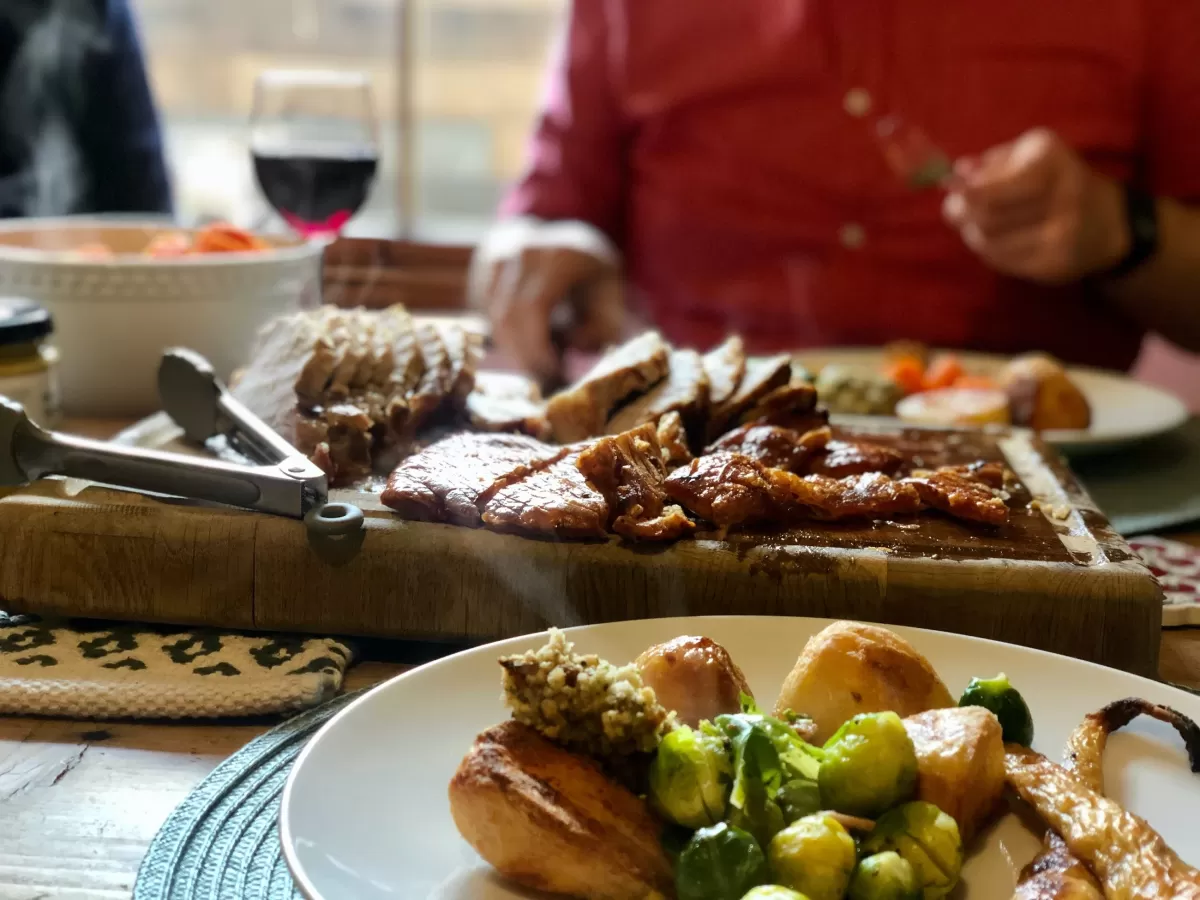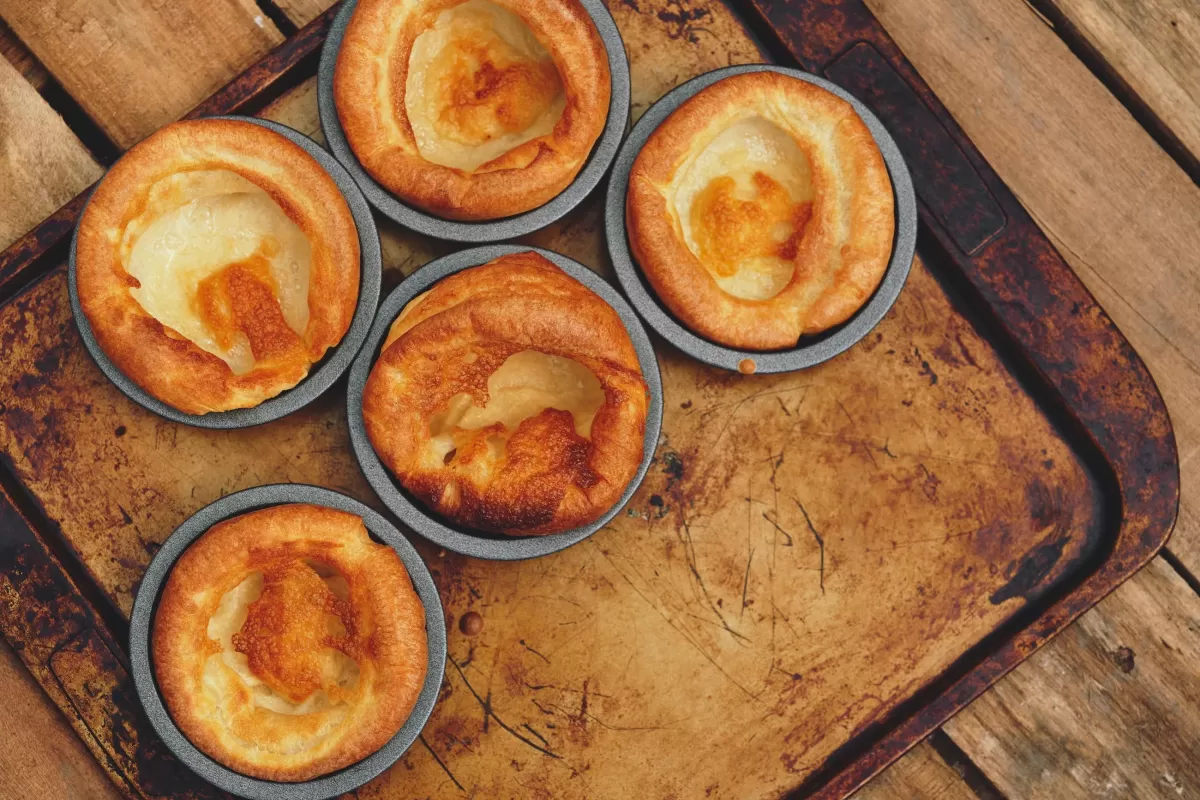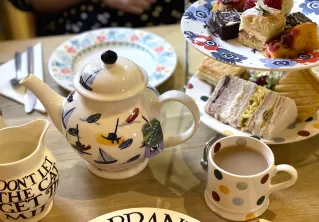The Best British Yorkshire Puddings: a recipe

To the Englishman, a roast beef dinner without a Yorkshire Pudding is like a fete without bunting, a pub without beer, or calling on friends without being offered a cup of tea. Unheard of, and quite disappointing should such rarities occur.
As Autumn moves steadily into Winter, most Sundays (not that seasons really have anything to do with our love for roast dinners) are for rest or rambling, rugby, often church, and a good old traditional lunch. The most popular choice by far, either enjoyed at home by the hearth, or down the local pub - and acceptable to all regardless of sporting or spirituality preferences is, “The Roast”. The humble Yorkshire Pudding of which, despite being very simple fayre, is actually the star of the show on many a British dinner plate.
They’ve been around for some time too! According to Wikipedia, in 1737, a recipe for “a dripping pudding” was published in Sir Alexander William George Cassey’s book “The Whole Duty of a Woman”. You can view a little of this book for free here, if you’re as fascinated by these quirky old books as I am.
Phew, what a title! I’d LOVE to meet a man brave enough to publish a book with a title like that in this day and age. Fellow author in the same Georgian period, Hannah Glasse, published a similar recipe with the name ‘Yorkshire’ Pudding. It is she who named the version, known as “Dripping Pudding”, which had been cooked in England for centuries, though these puddings were much flatter than the puffy versions made today. (Be warned, if your batter not cool enough, and your fat not hot - your intended Yorkshire Pud may indeed end up a Dripping Pud instead - still yum, just not the same).
It has been suggested that the pudding got its ‘Yorkshire’ name due to the region’s association with coal, and the higher cooking temperatures it produced which makes batter crispier.
For too long, many of us have been reliant on a lady known as “Aunt Bessie” and her convenient frozen offerings. She’s great to lean on in a bind, especially when time is tight - she’s certainly no stranger to my deep-freeze - but homemade will always trump dear ol’ Bess.
![]()
 If you’d like to be a purist about it, Yorkshire pudding should be served as a first course with thick gravy to dull the appetite and fill you up so that the expensive cuts of meat stretch further.
If you’d like to be a purist about it, Yorkshire pudding should be served as a first course with thick gravy to dull the appetite and fill you up so that the expensive cuts of meat stretch further.
To be extra purist, only serve Yorkshire Puddings with Beef. However, I am quite certain in my three and a half decades of greediness and observation experience, that most British families are happy to have a Yorkshire with any and all cuts of meat. Some even have them with jam!
They are a real highlight of the meal. No longer widely eaten as a first course, but joining the rest of the plate - often as the star of the show. It’s not uncommon to want two, or even three!

Our favourite Yorkshire Vet, the late great James Herriot had a thing or two to say about Yorkshire Puddings…
“Yes, I’ll come right away”. I put down the receiver, rubbed my ear and turned to my wife. Helen looked up from the table with the stricken face of a woman who can visualise her Yorkshire pudding sagging into lifeless ruin. “Oh surely you don’t have to go right this minute?” from The Best of James Herriot
“Some families like their pudding cooked in individual small round tins, but most had one cut into squares. Crisp corner pieces were the choice of some members of the family, while others preferred a softer square from the middle”. JH
James Herriot’s books are a real pleasure, a wonderful bucolic time warp, whisking you away into a simpler time of farming and life in the Yorkshire Dales. See my favourite book of his here on Amazon. It includes recipes!
I must admit, when it comes to yorkshires, I am partial to a slightly stodgier, softer pudding myself! I wouldn’t fight you for the cripsy bits. I like mine perfectly bready and pillowy - delicious when you use the well of the pudding itself to create a “gravy pool” on your plate. Yum!
![]()
How to make British Yorkshire Puddings
The one thing you must must must remember when making Yorkshire Puddings is that your batter must be as cold (and as rested) as possible, and the cooking fat as scorchingly hot as possible.
The chemistry of cold meeting hot gives you the rise you desire. I like to make my batter early in the morning, leaving it to rest in the fridge, and then cook the puddings first, before all else! They will re-heat very well at the end of the cooking session in the residual heat of the oven as you’re laying everything out.
If you prefer to use the dripping (fat) from the joint of meat to make yours, then you will of course need to wait until the end, and whack the heat back up to achieve the rise. It’s all a matter of personal preference and what you are comfortable with. It’s well worth experimenting to find a method that’s best for your own cooking style.
Just remember to make the batter early, and chill…
If you’d like to be extra British about it, make sure to whip your batter up in this fabulous “Fortnums Provisions” bowl. The stoneware keeps things nice and chilly for longer too.
This recipe makes roughly 8-12 medium sized Yorkshire Puddings.
Yield will depend on the size of your tin. I use a 12 cup muffin tin to make mine!

![]()
Ingredients for Traditional Yorkshire Puddings
- 100g (4oz or ½ cup) Plain Flour (All Purpose)
- 225ml (8 fl oz or 1 cup) Whole Milk
- 3 large Eggs
- ¼ tsp Salt
- 125ml (4 fl oz or ½ cup) Sunflower, Rapeseed, or Canola Oil (or dripping)
Method
- First make your batter by mixing all ingredients together (except the oil) until a smooth batter consistency is achieved. It is best to use an electric whisk or stand mixer if you can, but work it until no lumps remain and small bubbles burst on the surface.
- Pour the batter into a jug (ideal, and great for portioning), or keep in the bowl. Cover and leave in the fridge to chill for a couple of hours, or preferably overnight! Do not remove until you are ready to cook them and the oven is up to temperature.
- Preheat the oven to 220*C/200*C Fan/400*F/Gas 7. Leave it to get nice and hot!
- Pour roughly a tablespoon of cooking fat into each hold of your tin. Transfer to the oven for about 5-10 minutes until the oil is piping hot.
- Carefully remove the tin from the oven and place on a heat-protected surface. Working quickly but safely, divide your batter between each hole, either by pouring from a jug, or using a ladle.
- Return to the oven and cook for 20-25 minutes until golden brown and well risen.
- Serve immediately, or if planning to reheat - remove from the tin and stand on a wire rack to cool. Allowing any extra fat to drip away and keep the puddings crisp.
Serve warm or cold with lashings of gravy!
*Reheat for 5-8 minutes in the residual heat of the oven.
*Can be made up to 3 hours ahead.
*Freeze in parchment paper, within tupperware.
*Cook from frozen for 10 minutes in a moderate oven.
![]()
It is an excellent good pudding; the gravy of the meat eats well with it. Hannah Glasse, Art of Cookery
Did you like this recipe?
I’d love to know if you try it! I know some of my American readers will know of these as “popovers”, what do you eat them with? Let me know in our group here.
I’m also quite intrigued to try one of these YorkyPud wraps - a foodie trip to your home county of Yorkshire is on the cards Mr Darling, take note! Shall we settle back in Settle?
I do hope you enjoyed this article, if you like our values here at The Darling Academy and found this post useful or inspiring, would you kindly consider supporting the blog.
Oh and don’t forget, if you’d like a few pointers for help in the kitchen, or some lovely templates for meal plans etc, check this out.
Happy Eating!
Alena xxx
All content and images in this article are copyright of The Darling Academy and are not to be shared or reproduced without our express permission. Affiliate links have been used in this blog post. Yorkshire, we love you!


